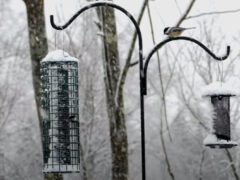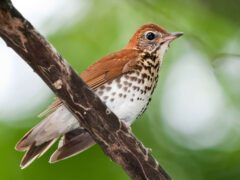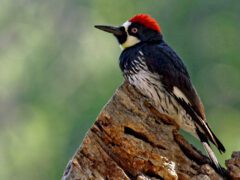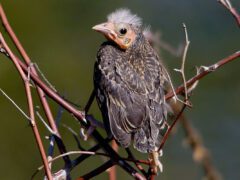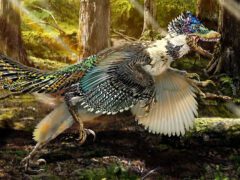Rough-legged Hawk Photo Gallery
Adult male light morph
Large hawk with fairly narrow wings. Note the black patches at the wrist and the white tail base with black band at the tip. Males tend to be more mottled on the wings with less of a black belly patch than females.
© Bryce Robinson / Macaulay LibraryWyoming, February 05, 2017Immature light morph
Large hawk with relatively narrow wings and a long tail. Note black patches at the wrist. Immatures have a lighter head and extensive black belly patch. The tail is white with a dark tip.
© Rodney Crice / Macaulay LibraryKentucky, December 10, 2013Adult female light morph
Breeds in the Arctic; typically seen wintering in cold, often snowy fields with patchy trees. Perches on slender branches and at the tops of small trees. Flies with easy wingbeats but soars less often than other raptors.
© Timothy Barksdale / Macaulay LibraryMinnesota, December 01, 1994Not all videos have soundJuvenile light morph
Note light head, mottled brown upperwing, and white tail base with dark band at tip. Juveniles have distinctive white panels in the primaries.
© Chris S. Wood / Macaulay LibraryConnecticut, January 28, 2017Adult male light morph
Strongly mottled with buff and reddish-brown above. Males have streaky underparts and barred legs. They usually have less of a distinct black belly band than females.
© Matthew Pendleton / Macaulay LibraryUtah, February 24, 2017Adult male light morph
Bulky hawk of open country and cold climates. Males have darker head and breast than females. Note dark patches at the bend of the wing (wrist) on the underside.
© Timothy Barksdale / Macaulay LibraryDecember 01, 1997Not all videos have soundJuvenile light morph
Hunts in open country and often perches on the ground. Note pale head and white base of tail with dark tip.
© Ian Davies / Macaulay LibraryMassachusetts, February 04, 2012Adult dark morph
Dark morph adults have pale flight feathers giving a two-toned appearance to the underwings. They also usually show white bands in the tail.
© Skye Haas / Macaulay LibraryMichigan, March 30, 2017Adult dark morph
Often hunts by turning into the wind and flapping to hover in place, while scanning the ground below.
© Timothy Barksdale / Macaulay LibraryMinnesota, December 01, 1994Not all videos have soundJuvenile dark morph
Dark morphs can be fully chocolate-brown except for pale undersides to the flight feathers, which are not visible when perched. The tail often has narrow white bands, but they can be indistinct. Eye darkens with age.
© Patricia and Richard Williams / Macaulay LibraryPennsylvania, February 28, 2015Adult dark morph
Dark morphs can have variable amounts of mottling on the back, wings, and belly.
© Harold Ziolkowski / Macaulay LibraryMontana, January 04, 2017Adult dark morph
Hunts by flying over open country, sometimes hovering into wind. Dark morph is mostly dark brown with contrasting white in the wings and tail.
© Larry Arbanas / Macaulay LibraryAlaska, June 16, 2007Not all videos have soundAdult male light morph
Males usually have darker heads, a streakier breast, and less of a black belly patch than females. The legs are feathered all the way to the feet, unlike most other hawks.
© Daniel Jauvin / Macaulay LibraryQuebec, April 08, 2016Adult female light morph
Large hawk with long wings. Female usually has a light head, pale breast, extensive black belly patch, and a white-based tail with black tip.
© Joel Adams / Macaulay LibraryColorado, January 21, 2017Adult male light morph
Males have streakier, darker breast than females and often have barred flanks.
© Shawn Billerman / Macaulay LibraryWyoming, November 22, 2015Adult male light morph
Feathering extends all the way to the feet, unlike on many other hawks. Males typically have darker chests than females.
© Steven Mlodinow / Macaulay LibraryColorado, December 27, 2016Habitat
Breeds in arctic tundra; usually seen in winter, when it hunts in open country including fields, marshes, prairies, and sagebrush. Perches on telephone poles and on the slender top branches of small trees.
© Ryan Schain / Macaulay LibraryMassachusetts, December 29, 2012Compare with Similar Species
Click on an image to compare
Species in This Family
Hawks, Eagles, and Kites(Order: Accipitriformes, Family: Accipitridae)
More to Read
Don't miss a thing! Join our email list
The Cornell Lab will send you updates about birds,
birding, and opportunities to help bird conservation.


























